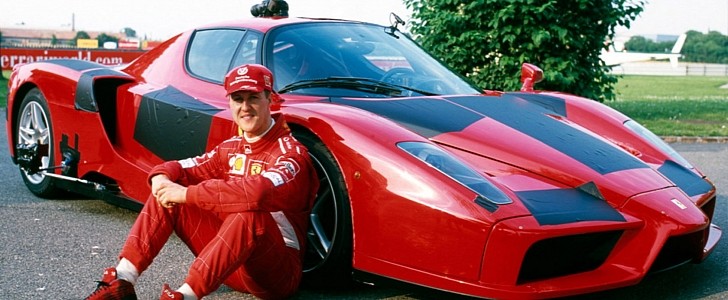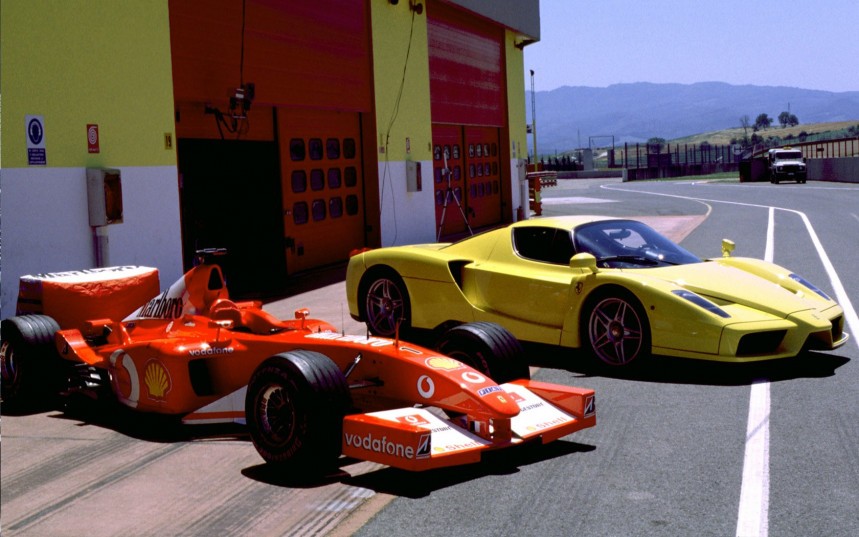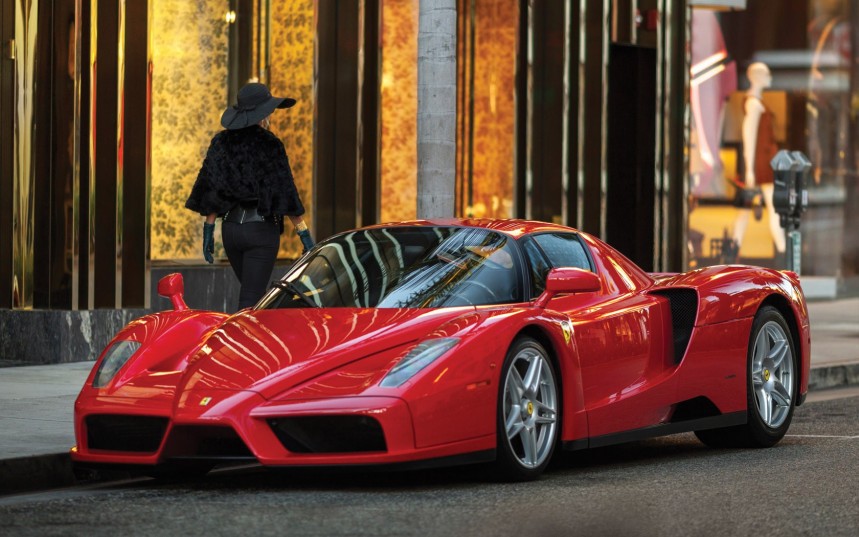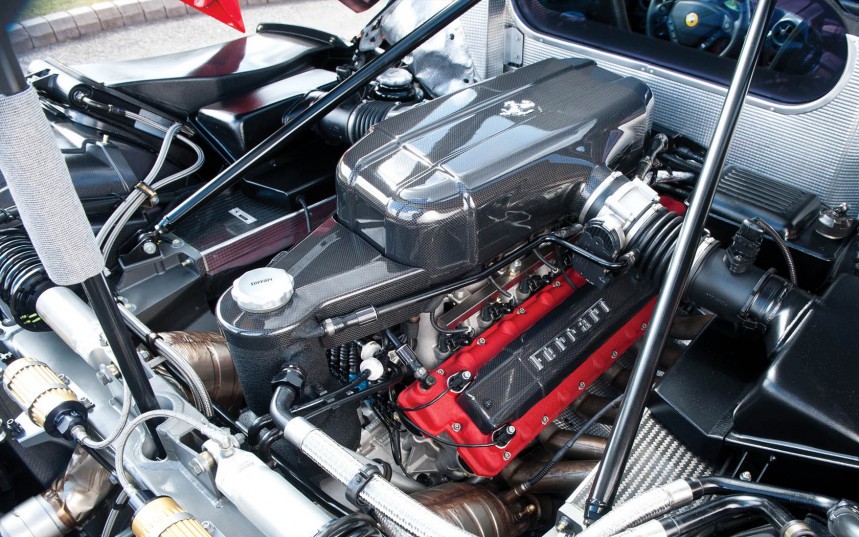In the early 2000s, the famed manufacturer enjoyed its greatest winning streak in Formula One history earning title after title in both constructors’ and drivers’ categories. To capitalize on this success, Ferrari decided to take the technology transfer pioneered in the F50 to another level by creating a new F1-inspired supercar, and the result was the revolutionary Enzo.
After building the exclusive 288 GTO, the successful track-oriented F40, and the pioneering F1-engined F50, Ferrari started developing a new supercar that would embody the very pinnacle of their technological advancements.
Testing started in 2001 when some very peculiar 348s that featured an overstretched rear end started appearing on the roads of Maranello. These were, in fact, test mules that hid a new mid-mounted V12 powerplant developed specifically for the new supercar.
A year later, the veil was dropped on the mysterious project, and the new car was revealed at the Paris Motor Show, bearing the name of the company’s founder.
Like its predecessors, the Enzo was conceived as the best Ferrari ever built; to back that up, engineers incorporated all the latest technological advancements developed in their successful Formula One cars.
This is obvious just by looking at the car, as its front section is heavily inspired by the F1 racers of the era both aesthetically and functionally. The large nose cone and composite flanks were specifically designed to channel airflow and increase downforce.
The rear, however, has an identity of its own, taking inspiration from past Ferrari models and employing an active aerodynamic spoiler. This technology was banned in F1 at the time, but it paved the way for the active aero features that we now see on most sports cars.
The body penned by Pininfarina head of designer Ken Okuyama was subjected to more wind tunnel tests than any other road-going Ferrari.
The Enzo sits on a lightweight carbon-fiber chassis with aluminum honeycomb panels, which increased rigidity, made the car safer, and added to the long list of technologies transferred from the world of racing.
Unlike the F50, which received the same engine used in the 1990 racecar, the Enzo would receive a new unit that was specifically designed for it by Scuderia Ferrari engineers.
Dubbed F140 B, the new naturally aspired 6.0-liter (366-cu in), aluminum-block V12 features four valves per cylinder, variable valve timing, and a Bosch Motronic ME7 fuel injection system, cranking out 651 hp (485 kW; 660 PS) at 7,800 rpm.
It was uncompromisingly built for raw power and huge torque at low RPMs, reaching a maximum value of 657 Nm (485 lb-ft) at 5,500 rpm. All this power was transferred to the rear wheels via a rear-mounted six-speed 'F1' automated manual gearbox controlled by paddle shifters placed behind the steering wheel.
This enabled the Enzo Ferrari to accelerate from 0 to 100 kph (0-62 mph) in just 3.65 seconds on its way to a top speed of 355 km/h (221 mph). Stopping power was provided by Brembo, which built a system specifically for the supercar. It was the first Ferrari to use carbon-ceramic brake rotors, which were only common in race cars back then.
Only produced in 399 units between 2002 and 2004, all Enzos were sold before production even began as Ferrari sent invitations to active customers, specifically to those who already owned an F40 and F50. Seven-time F1 World Champion Michael Schumacher owned one and was also actively involved in the development and testing of both the road-going model and the track-oriented FXX.
Built to highlight the technological advancements of the era, the Enzo paved the way for current generation Ferraris, which feature many components pioneered in that era. Carbon-ceramic rotors are now widespread and its legendary V12 gave birth to a whole family of high-performance engines.
Testing started in 2001 when some very peculiar 348s that featured an overstretched rear end started appearing on the roads of Maranello. These were, in fact, test mules that hid a new mid-mounted V12 powerplant developed specifically for the new supercar.
A year later, the veil was dropped on the mysterious project, and the new car was revealed at the Paris Motor Show, bearing the name of the company’s founder.
This is obvious just by looking at the car, as its front section is heavily inspired by the F1 racers of the era both aesthetically and functionally. The large nose cone and composite flanks were specifically designed to channel airflow and increase downforce.
The rear, however, has an identity of its own, taking inspiration from past Ferrari models and employing an active aerodynamic spoiler. This technology was banned in F1 at the time, but it paved the way for the active aero features that we now see on most sports cars.
The body penned by Pininfarina head of designer Ken Okuyama was subjected to more wind tunnel tests than any other road-going Ferrari.
Unlike the F50, which received the same engine used in the 1990 racecar, the Enzo would receive a new unit that was specifically designed for it by Scuderia Ferrari engineers.
Dubbed F140 B, the new naturally aspired 6.0-liter (366-cu in), aluminum-block V12 features four valves per cylinder, variable valve timing, and a Bosch Motronic ME7 fuel injection system, cranking out 651 hp (485 kW; 660 PS) at 7,800 rpm.
This enabled the Enzo Ferrari to accelerate from 0 to 100 kph (0-62 mph) in just 3.65 seconds on its way to a top speed of 355 km/h (221 mph). Stopping power was provided by Brembo, which built a system specifically for the supercar. It was the first Ferrari to use carbon-ceramic brake rotors, which were only common in race cars back then.
Only produced in 399 units between 2002 and 2004, all Enzos were sold before production even began as Ferrari sent invitations to active customers, specifically to those who already owned an F40 and F50. Seven-time F1 World Champion Michael Schumacher owned one and was also actively involved in the development and testing of both the road-going model and the track-oriented FXX.
Built to highlight the technological advancements of the era, the Enzo paved the way for current generation Ferraris, which feature many components pioneered in that era. Carbon-ceramic rotors are now widespread and its legendary V12 gave birth to a whole family of high-performance engines.











